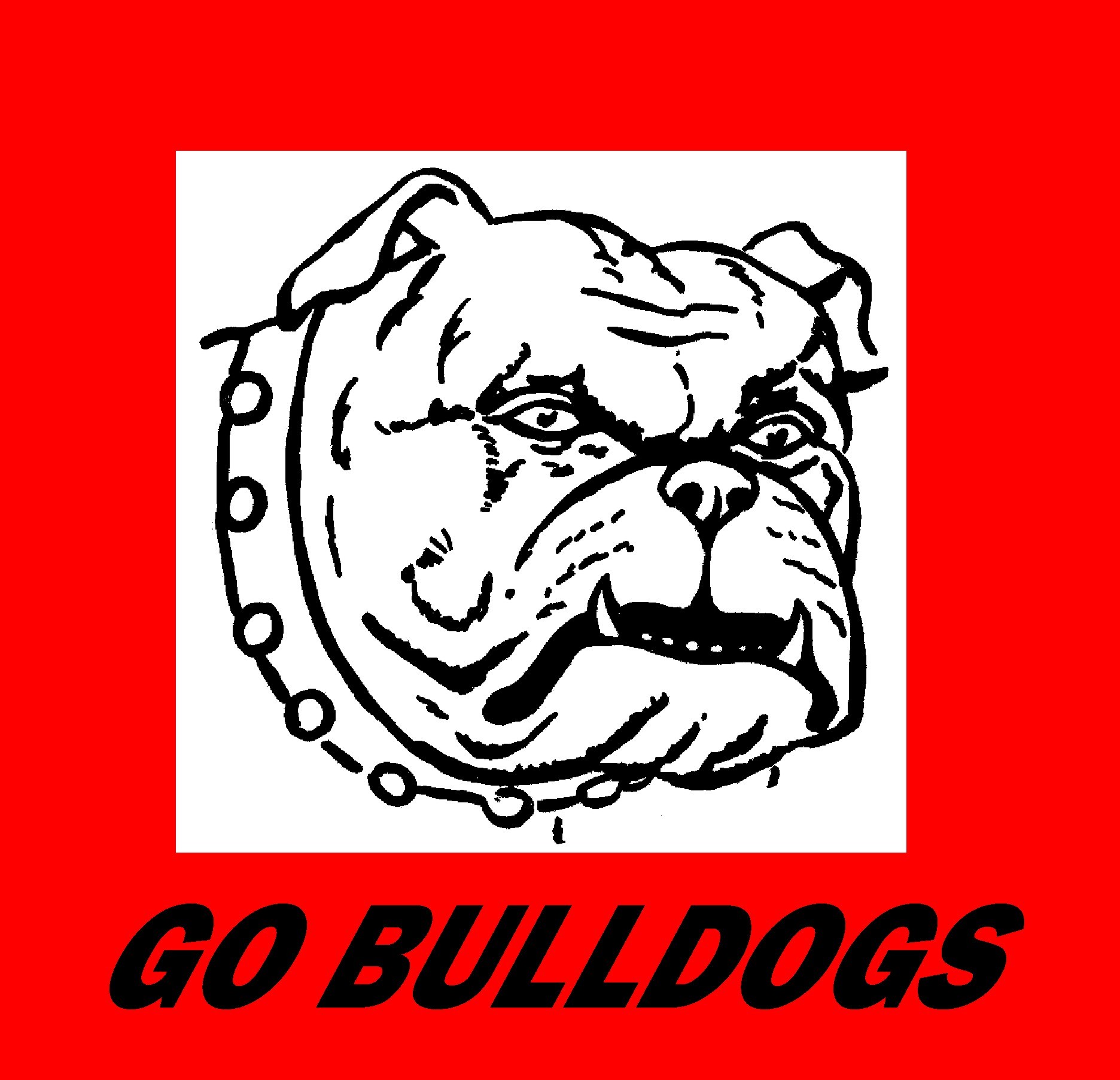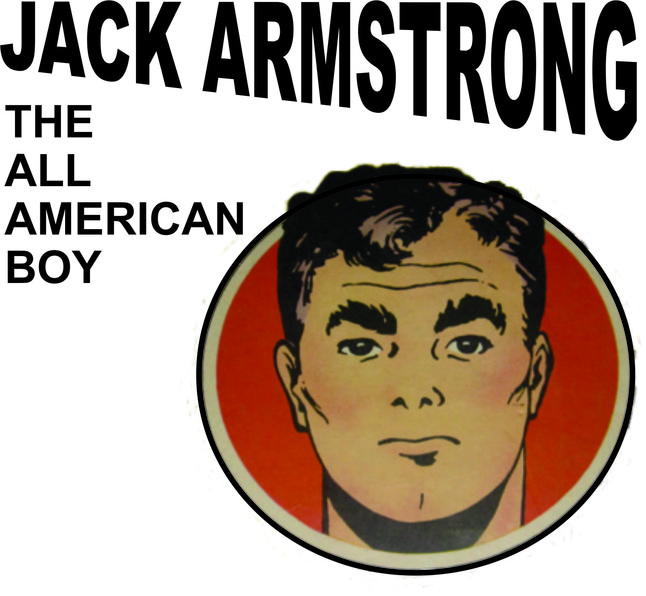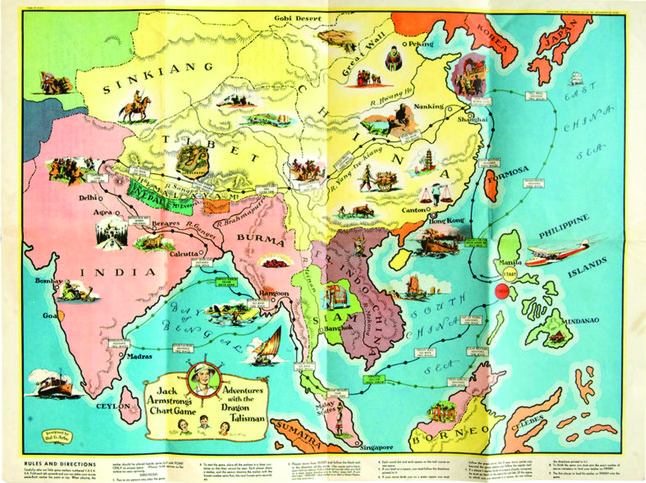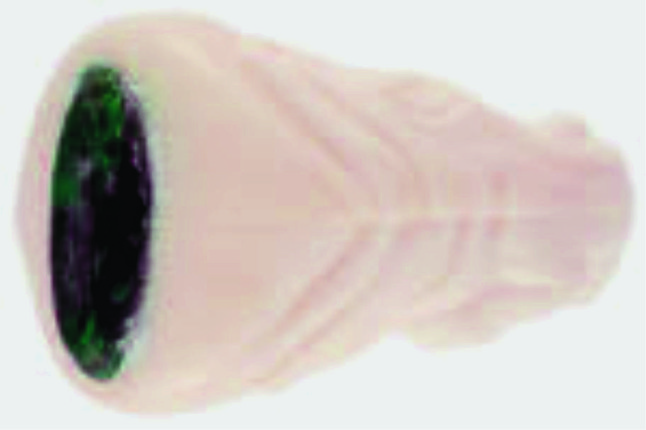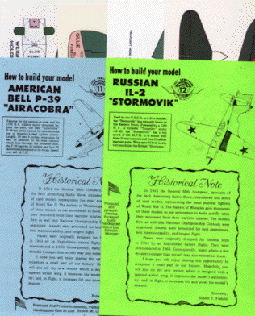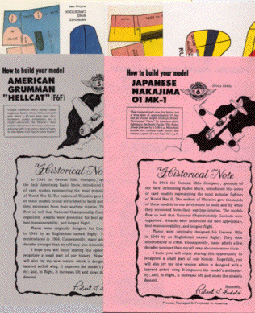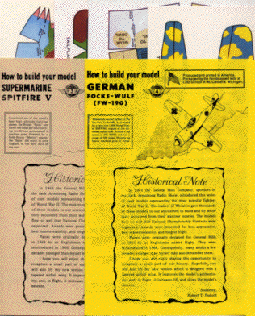Jack Armstrong
Jack Armstrong!
Jack Armstrong
Jack Armstrong!
Jack Armstrong!
Quintet:
Wave the flag for Hudson high, boys!
Show them how we stand.
Ever shall our team be champions
Known throughout the land.
Quintet humming
Announcer:
Wheaties, Breakfast of Champions
Brings you the thrilling adventures
of
Jack Armstrong
The Allllll-American Boy!
CREATED IN CHICAGO BY ADVERTISING AGENCY Blackett-Sample-Hummert and writer Robert Hardy Andrews, Jack Armstrong, the All American Boy is one of the best-remembered radio shows designed for the teen and pre-teen audience. The program first aired as a daily 15 minute serial on July 31, 1933 and maintained its popularity until its final broadcast on July 28, 1951. Unfortunately, only a few of the original broadcasts and written scripts survived the years.
While every episode opened with a vocal quintet singing the school fight song, Jack Armstrong spent relatively little time behind a desk or on the gym floor. Instead, story lines revolved around the globe-trotting adventures of Armstrong, his friends Billy Fairfield and sister Betty, and their Uncle Jim Fairfield, who added a mature and fatherly component to the show. Uncle Jim frequently visited exotic parts of the world in conjunction with his business and would take Armstrong and the Fairfield siblings with him.
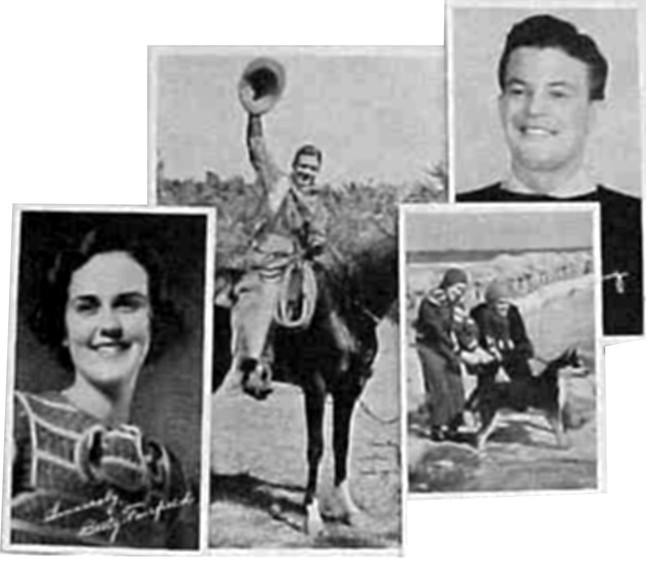
Left to Right: Betty Fairfield (Sarajane Wells); Jack Armstrong (Jim Ameche);
Betty, Jack, & Friend; Jack Armstrong
To the listerners, the trips were as vivid as a travelogue and provided fascinating and colorful details about the lands that were visited. Furthermore, those travels always resulted in thrilling adventures for the foursome though some involved the most improbable circumstances ever to grace the early evening time slot. As bizarre as some plots may have seemed, the show’s producers conscientiously consulted anthropology professors to ensure an accurate portrayal of each foreign setting was presented.
The secret of the program’s longevity was probably Armstrong’s extreme flexibility. Jack could do everything, and often did. But most of all, he effectively adapted to his changing environment. He was a high school football hero and, at the same time, equally comfortable speaking a few words of Zulu in deepest Africa. No one knew where Jack's next adventure would take him, which kept his confident listeners tuning in to discover how he would prevail.
During the war years, Armstrong initiated patriotic efforts on the home front and consistantly outsmarted spies and saboteurs. When Jack finally graduated from high school in 1947, he became a government agent for the Scientific Bureau of Investigation. The program was renamed Armstrong of the SBI and shifted from a 15-minute serial to a half-hour complete-story format.
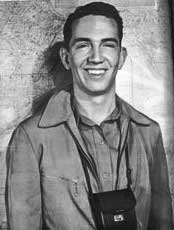 |
| Charles Flynn as Jack Armstrong |
Six different actors played the part of Jack Armstrong, including Jim Ameche (1933-38) and Charles Flynn (1939-43 and (1944-51). The program's best-known announcer was the legendary Chicago voice, Franklyn MacCormack, who delivered his commercials with the help of an a cappella quintet.
At the beginning of the 1936 season, the show's producers wanted an established, quality author to raise the show's caliber of writing and hired the sucessful adventure writer Talbot Mundy. He was engaged at the same time that Jack Armstrong switched from CBS to the NBC-Red Network, and his authorship was widely advertised along with the change in stations. Publicity declared that Armstrong would travel to India, Tibet, China, the Himalayas, and the Gobi Desert - all favorite locales of Mundy’s adult fiction.
Like the teenage hero whose adventures Mundy was now creating, his own early years were defined by travel. In 1895, at 16, he fled the strict Victorian ties of his native England, crossed the entire northern frontier of India, journeyed into Tibet, spent 4 years in Africa, and then, in the wake of World War I, explored the Middle East.
.gif)
Click on the arrow (above) to hear the Jack Armstrong "Adventure Of The Sunken Reef:" Episode 3, which was broadcast on December 25, 1940.
Sponsored exclusively by Wheaties over the life of the program, Jack Armstrong transformed General Mills into a major marketing phenomenon. Unique objects which played a prominent role in the show’s storyline would be offered as "premiums" to listeners who mailed in a dime and a Wheaties box top. Kids consumed mountains of Wheaties to obtain box tops which could be redeemed for rings, telescopes, pedometers, torpedo flashlights, luminous bracelets, secret bombsights, Tru-Flite model planes, and more.
The premiums typically were sent to a half-million to a million listeners, which according to Armstrong researcher and enthusiast Fred King, indicated the close attention the show received by at least one in every 7 young Americans. Jack Armstrong, the All American Boy left air after captivating a vast and loyal audience for 18 years and after producing a huge number of highly sought after premiums, which are still in demand today.
| Return to Beginning |
RADIO PREMIUMS
JACK ARMSTRONG AND HIS SPONSOR WHEATIES/GENERAL MILLS worked extraodinarily well together. He quickly became a champion at selling Wheaties, and General Mills quickly became a major radio advertiser.
Legend has it that the first premium offer so overwhelmed General Mills with orders that the nationwide Wheaties' supply was demolished for months. Later offers were carefully planned. Before the new offer was broadcast, trainloads of cereal were stationed at strategic points around the country ready to replenish grocers' shelves.
The quality and taste of the cereal was secondary to kids; what they wanted was the box top, which could be used to obtain a Jack Armstrong treasure. Those "treasures" were numerous and almost any tangible object mentioned in a story line could be expected to turn up as a premium.
1. Stamp Kit, (1935), Wheaties
.jpg)
2. Jack Armstrong Game: Adventures with the Dragon Talisman, (1936), Wheaties
A letter from Jack Armstrong is included with the game and describes the game pieces and the enclosed brass talisman, which he explains could be used as a watch fob, neck piece, or pocket piece. On the talisman is a picture of a fierce dragon with a Chinese inscription below it. The note translates: "China, the Key to the Door of the Room Is Very Precious."
The 20" x 26.5" map/game board shows an overhead view of Southeast Asia plus the designated trail to follow during game play. There are many small illustrations of native people, scenes, plus a large image of the talisman on the board. The rules and directions are printed in bottom margin. Also included are a cardboard spinner and six die-cut cardboard markers.
|
|
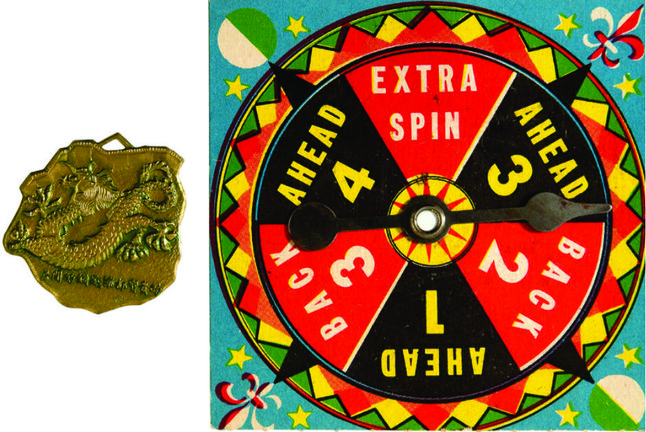 |
3. Jack Armstrong Secret Whistling Ring and Whistle Code, (1937), Wheaties, 1 Box-Top + 10¢
The ring has Egyptian symbols on each side, and the top has a working siren whistle. The ring is covered with a beautiful gold brass luster.
Jack Armstrong's Secret Whistle Code is included with the ring, and it is made up of short and/or long whistles. For example: Four short whistles means, "We're Being Watched."
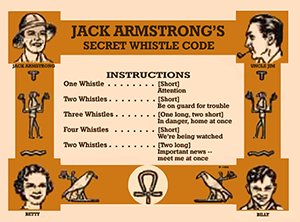 |
.jpg) |
4. Series 10 Bob Feller Cleveland Indians, (1938), Wheaties
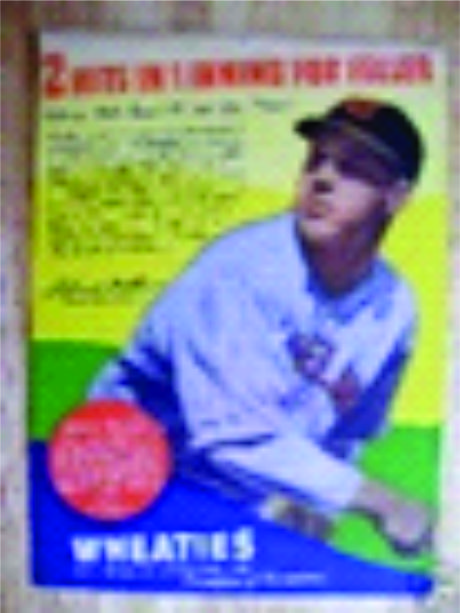 |
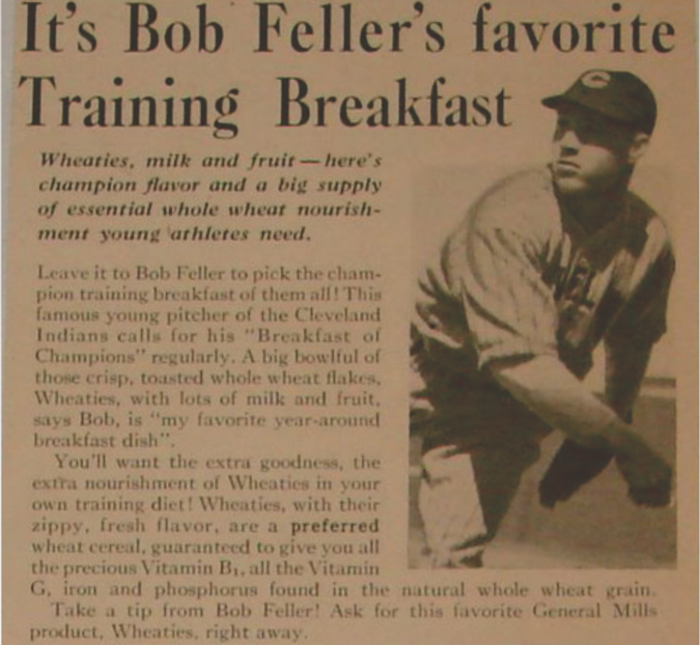 |
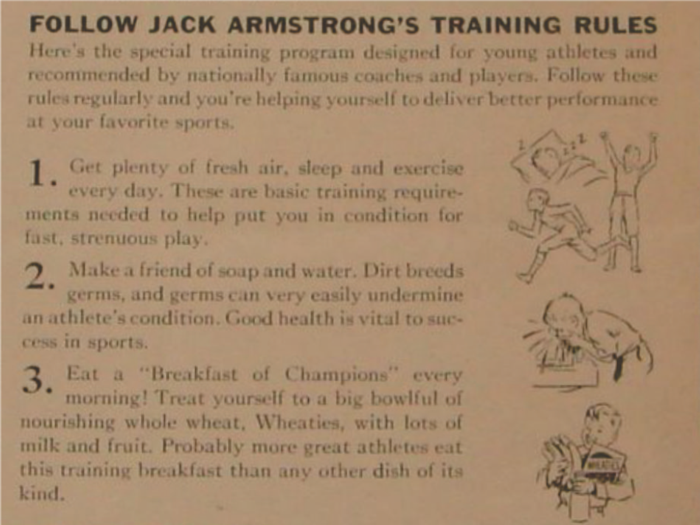 |
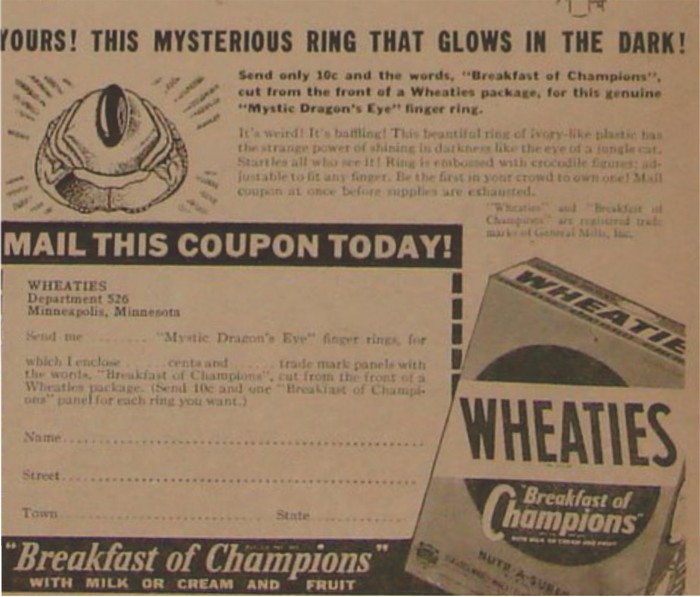 |
| Note the mail-in coupon for a Dragon Eye Ring that follows Bob Feller's tips for healthy breakfasts. | |||
5. Telescope (1938), Wheaties, 2 Box-Tops + 10¢
The metal telescope is 6.75 inches long and is covered with textured paper. It extends to 10.25 inches. “Jack Armstrong Explorer” is written in raised text on the paper. (Premium requests numbered almost 6 million.)

6. Pedometer, (1938), Wheaties
This pedometer cost only 10 cents and a Wheaties box top; and best of all, it was just like the one Jack Armstrong used on his program.
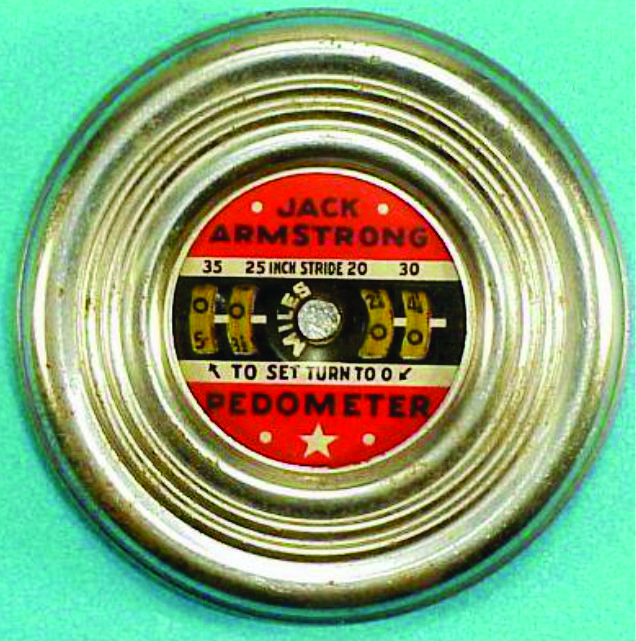
7. Betty’s Luminous Gardenia Bracelet, (1940), Wheaties, 1 Box-Top and 10¢
This was just like the bracelet that Betty wore!
8. Captain Whistle Badge, (1940), Wheaties
9. "Champ Stamps," (1940), Wheaties
The stamps were simply pictures of different champions from various fields printed on the backs of Wheaties packages. Each stamp had a short biography of the individual featured. A total of 39 stamps were available.
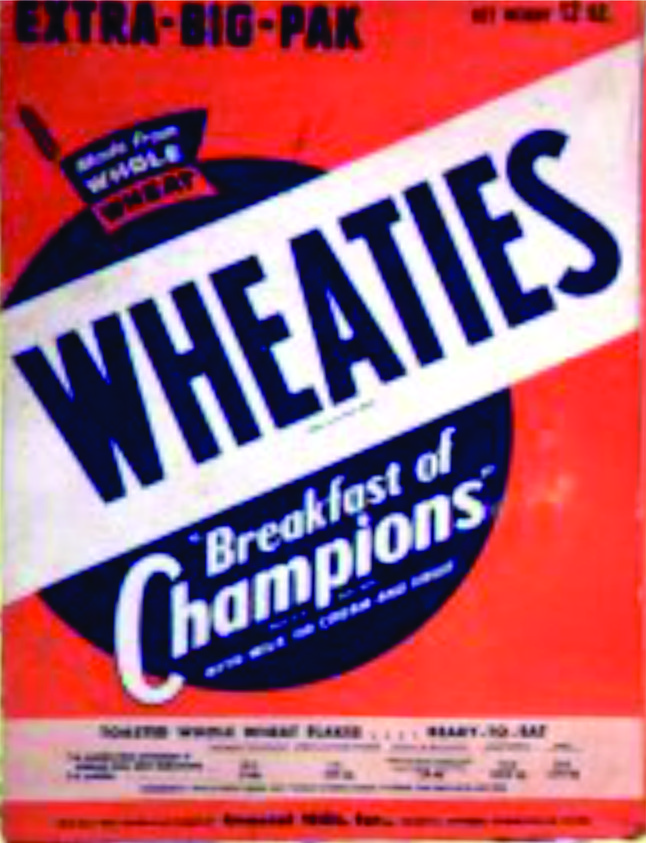 |
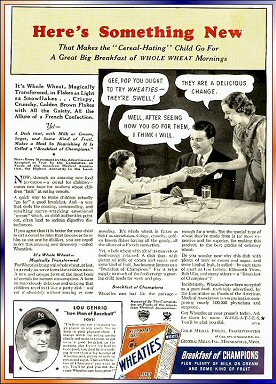 |
10. Jack Armstrong Dragon’s Eye Ring, (1940), Wheaties, 1 "Champ Seal" + 10¢
This ring has creamy white plastic bands that are designed as crocodiles with open jaws. The top of the ring has a raised very dark emerald green plastic oval stone. In the dark, the plastic stone becomes the “Dragon’s Eye” as it does not glow; the rest of the ring--bands and stone mounting, do glow.
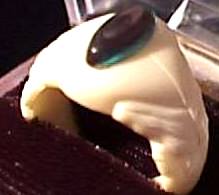 |
|
11. Listening Lieutenant Whistle Badge, (1940), Wheaties
This premium, as produced, consisted of a piece of brass folded in half and had a small hole below a star design. It could be used as a whistle.
12. Listening Squad Certificate, (1940), Wheaties
| Return to Beginning |
13. Listening Squad Kit, (1940), Wheaties
14. Luminous Baseball Pencil, (1940), Wheaties
About 1000 of these were requested and sent.
15. Luminous Gardenia Brooch, (1940), Wheaties
16. Magic Answer Box, (1940), Wheaties
Six hundred-thousand dark red tin Magic Answer Boxes were sent in answer to the demand for this clever offering. The top center of the box has a window to display an interior silver metal pointer that lines up with a series of answers printed on the tin above the window opening. The user poses a question and then places a thumb over an area on the side of the box which has small openings. Heat causes a thin cellophane strip on the interior to curl thus moving the finely balanced pointer. It takes a few seconds for the heat to build up, but the needle will move and does line up with printed answers ranging from "So What!" and "Yes" at the far left and then going in small increments to various answers on the right from "Maybe," "Try Again," "No," "Check!" to the final "Wow!" Directions for using the premium, various suggestions for games, and lists of questions to pose are included.
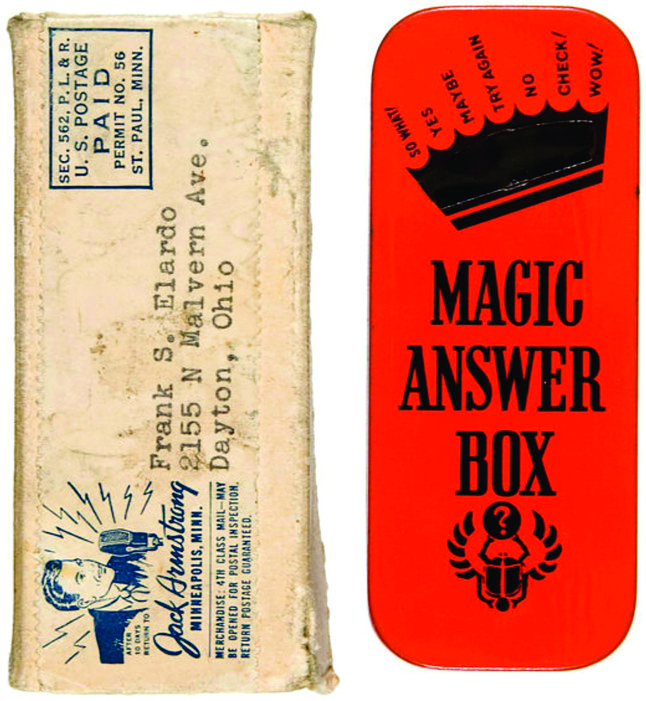 |
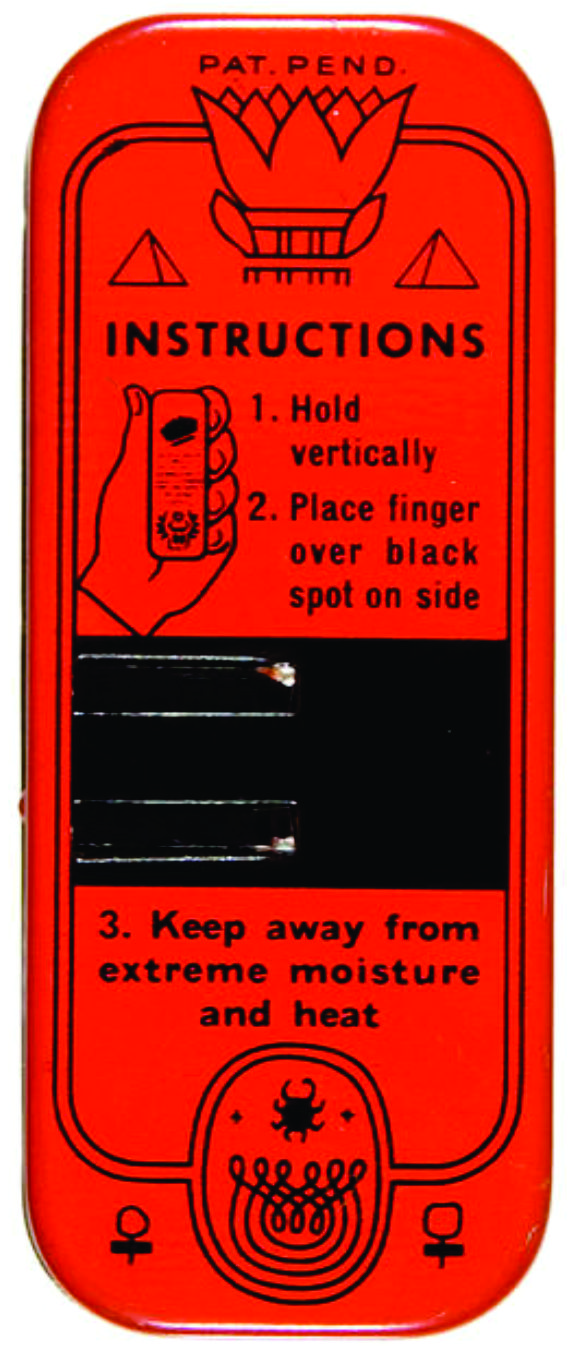 |
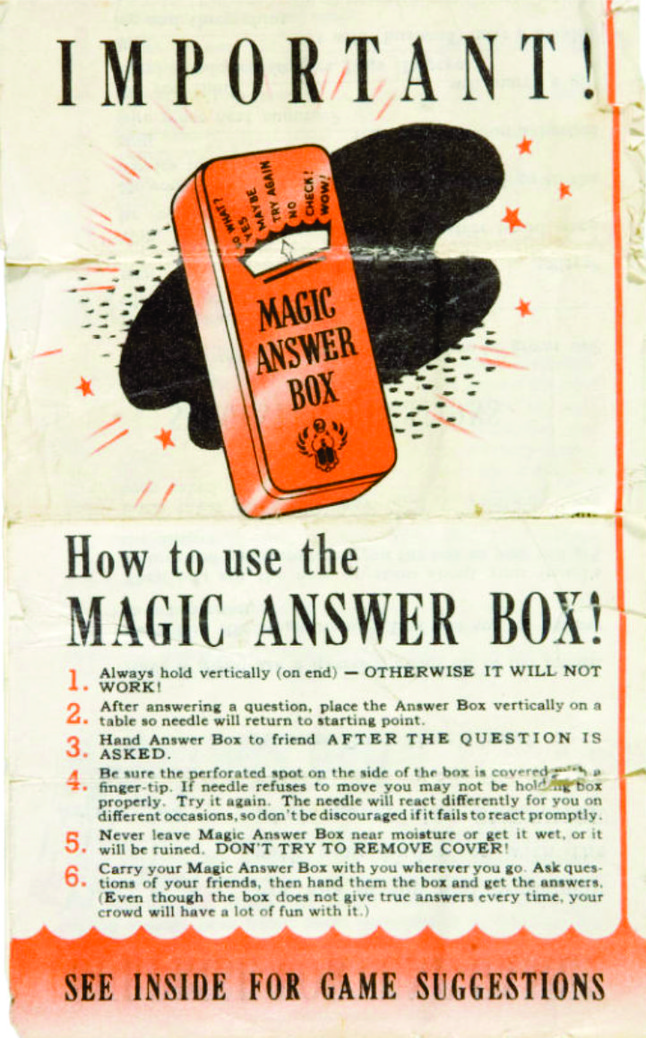 |
17. Sky Ranger Airplane, (1940), Wheaties, 2 Box-Tops
The Sky Ranger Airplane has a cardboard tube body with aluminum wings. One wing originally came in a paper sleeve instruction sheet. A rubber band was attached to the tail which ran through the body to the propeller. "Wind it up & let 'er go!" said the instructions.
This premium was extremely successful--6 milion were distributed - but not many have survived because the plane was quite fragile. The instruction sleeves are practically nonexistent, and the partial shipping box shown below is the only one known!
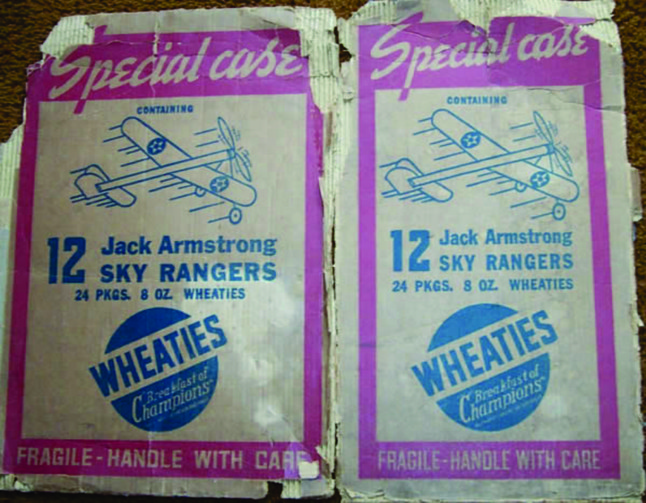 |
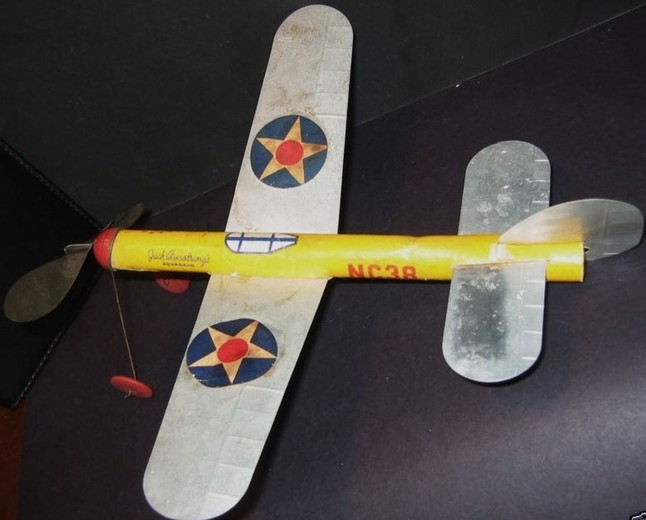 |
18. Baseball Folio, (1940s), Wheaties
19. Champion Belt, (1940s), Wheaties
20. Sports Neckerchief, (1940s), Wheaties
21. Blackout Luminous Safety Belt, (1941), Wheaties
22. Jack Armstrong Picture Book, (1941), Wheaties
23. Pistol Flashlight, (1941), Wheaties
The battery powered glow-in-the-dark Jack Armstrong 50th Century Flashlight Pistol was advertised to "shoot" a ray of light! It was offered for a dime and a Wheaties box top!
The pistol was also offered in an insert with the Lone Ranger National Defenders Portfolio kit. Since General Mills makes both KIX & Wheaties cereals, it is not surprising that this insert was included with the portfolio kit.
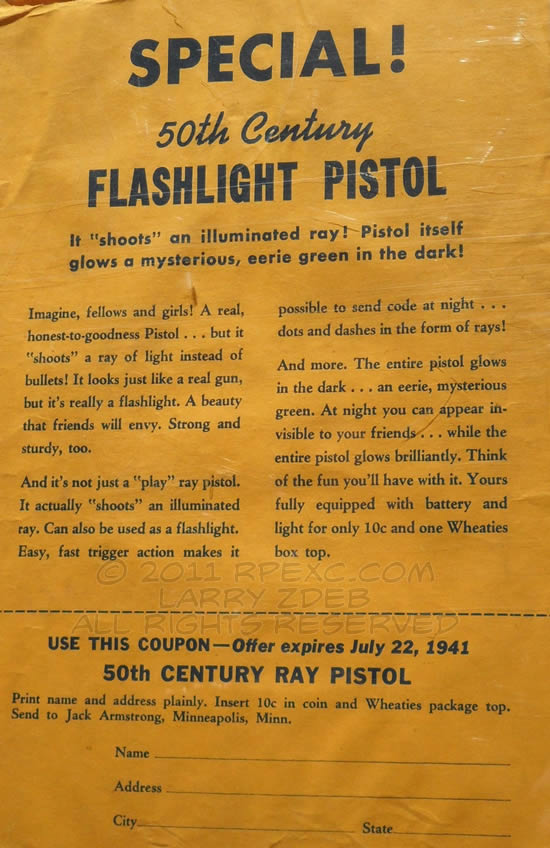 |
 |
24. Jack Armstrong's Sound Effects Kit, (1941), Wheaties
The Sound Effects Kit includes a 4.5" x 12.5” black and white sheet of paper with an image of a microphone. This was to be cut out and wrapped around the mailing box. A broom handle was inserted into one end to complete the microphone. A page with instructions on one side and a “Spy Hunt” script on the other is included too. Sound effect items were included: 2 different painted tin whistles, small piece of sand paper, a sheet of orange cellophane paper, and a balloon.
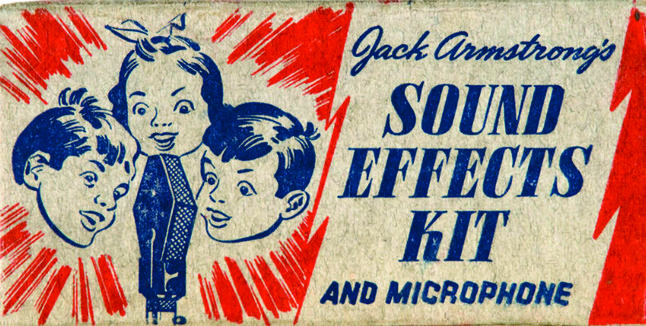 |
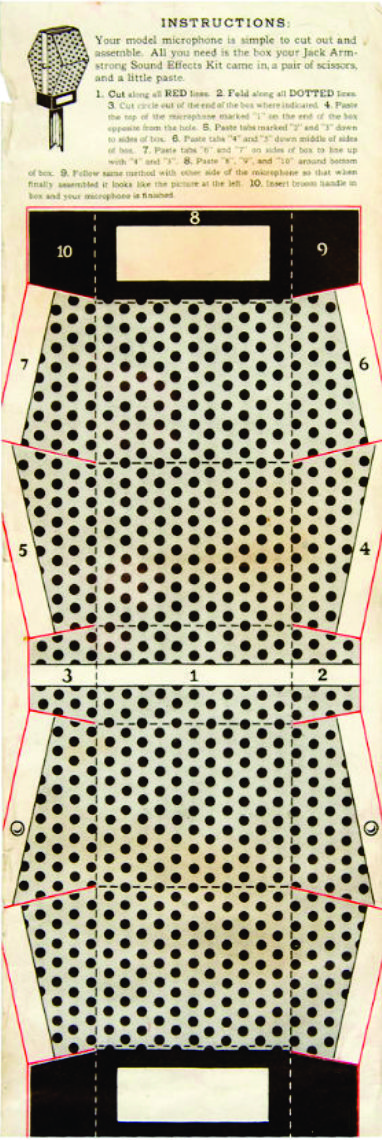 |
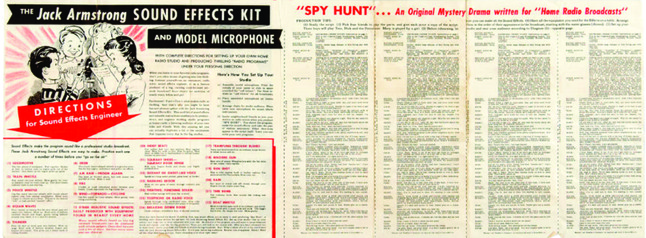 |
| Return to Beginning |
25. “Write A Fighter Corps" Manual, with Patches and Transfer Stars, (1942), Wheaties
This was an offer to join the “Write-a-Fighter Corp” (WAFC) for only a postcard. No box top or money was necessary; kids were asked to buy war stamps instead. Those joining received stationary and envelopes to write to a WWII serviceman, six honor bars and stars, a stencil for the stationary, and a manual on how to write to servicemen. If the member got 5 other kids to join, he or she could become a squadron leader.
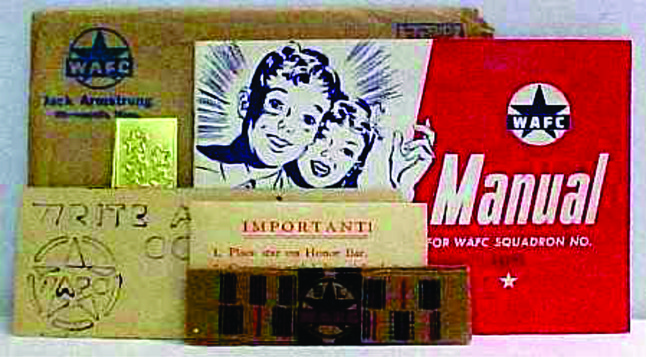
26. Lie Detector, (1942), Wheaties
27. Secret Bombsight with 3 Bombs, (1942), Wheaties
Immensely popular, the bombsight is a wooden replica of the famous Norton Bombs sight. The body of the piece is covered by a paper label with 5 simulated gauges and dials - captioned, for example, "Altitude Adjuster . . . Numbers In Thousands Of Feet." On the narrow end is a green wooden revolving cover which allows the loading of three red wooden bombs. Another edge of the piece has a green wooden viewing tube; and when looked into, there is a pair of cross hairs over a mirror that reflects whatever is below the hole on the underside of the device.
The bomb launching is achieved by turning the green wooden revolving cover to drop each of the three bombs individually. An "Official Instruction Manual" has 15 different ship and submarine targets that could be cut-out.
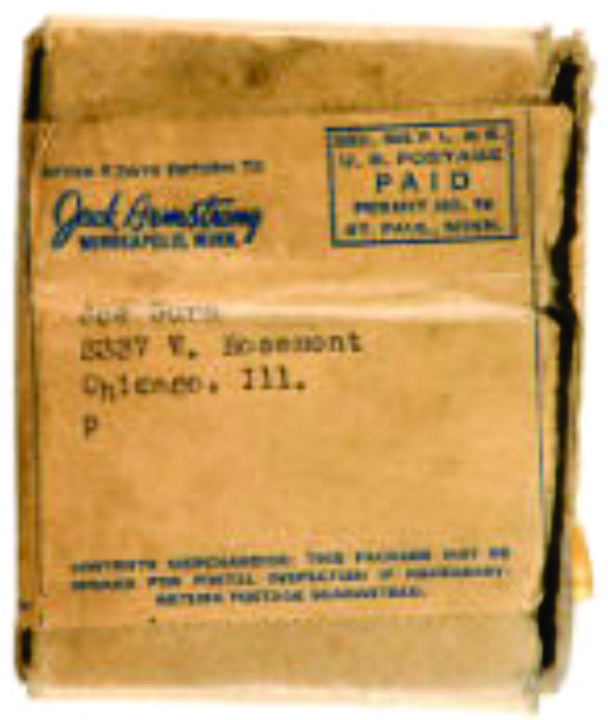 |
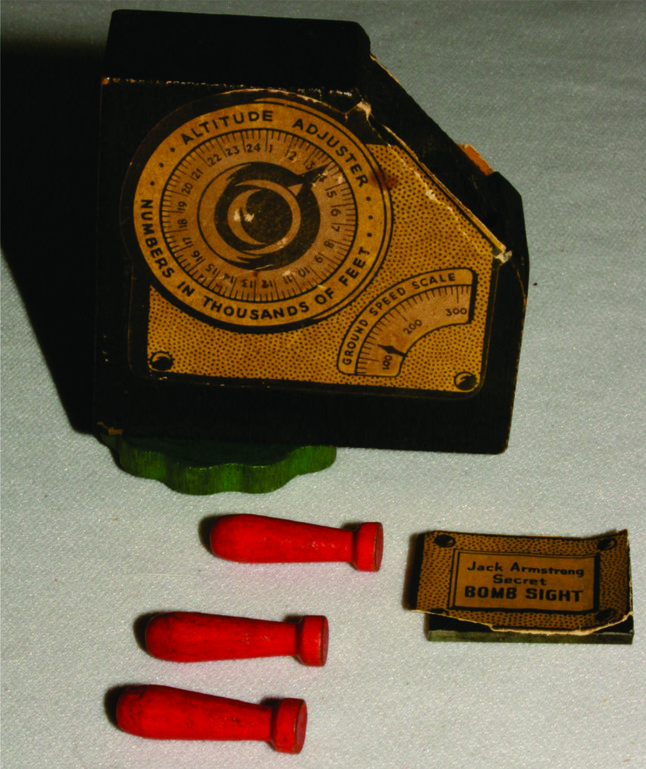 |
28. WAFC Banner, (1942), Wheaties
General Mills sent 940 banners to school rooms.
29. Cloth Patch, Future Champions of America, (1943), Wheaties
| Return to Beginning |
30. Future Champion Manual, (1943), Wheaties
The Jack Armstrong Future Champions of America Manual was the epitome of responsible radio advertising. The 38-page manual came with a patch and stars for accomplishments.
Each manual contained:
- F.C.A. training rules
- A nutritional chart
- A conditioning chart
- Guides on how to organize your own team
- Instructions on how to earn and wear your stars
- Champion test standards
- Three pages of “true champions that were made–not born,”
including tennis star Bobby Riggs, swimming star Gloria
Callen, and skating star Roy Shipstad.
The manual’s last page contained the following pledge: "In joining the Future Champions of America I promise to live up to its ideals of fair play and wholesome exercise, to keep myself physically fit to the best of my ability, and to cooperate with my teammates and our coach at all times.
“I will be faithful to the schedule of activity as outlined in this Manual and will add service stars to my insignia only after I have earned them fairly.”
This was the type of philosophy adhered to by both sponsors and programs that dominated the air waves of the Golden Days of Radio. With such a responsible advertising regime it’s no wonder the association between sponsors and programs lasted for years.
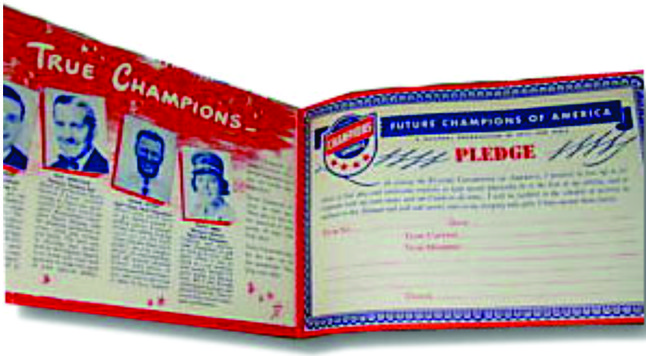
31. Library Of Sports Books, (1945-46), Wheaties
There were 14 different “Want to Be a ___________ Champion?” booklets, each written by coaches and athletes. They covered a wide range of sports and were written for girls as well as boys. This is #2 in the series and written by Lew Fonseca. It measures 5" x 7," has 30 pages, and represents several players, who are listed to the right of the premium.
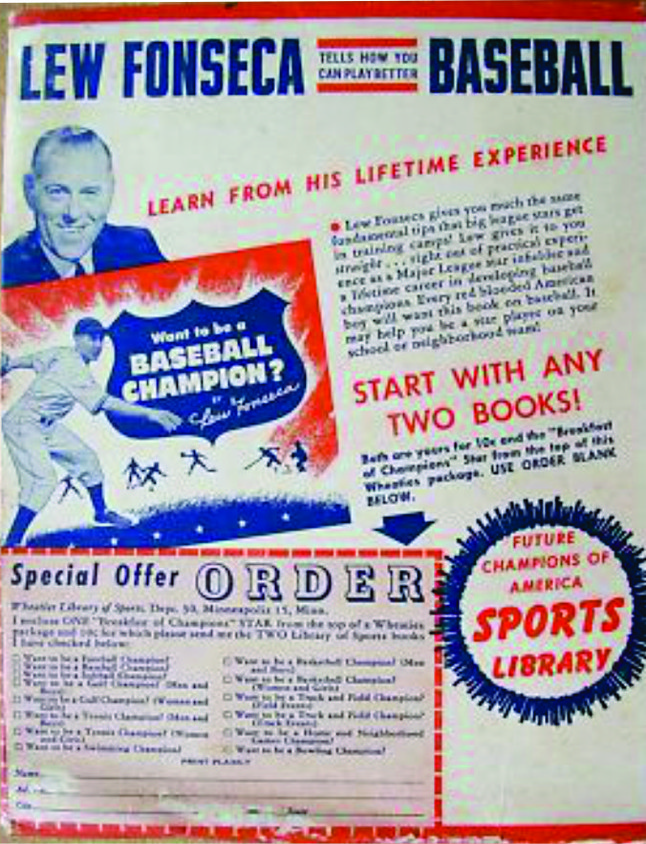 |
.jpg) |
Chet Laabs, St. Louis Browns |
All of the titles were listed on the back of Wheaties packages as well as information on how to order the booklets.
32. Wooden Baseball Pencil, (1943), Wheaties
33. Model Ship: Sloop, (1943), Wheaties
Tru-Flite Model Airplanes, (1943), Wheaties
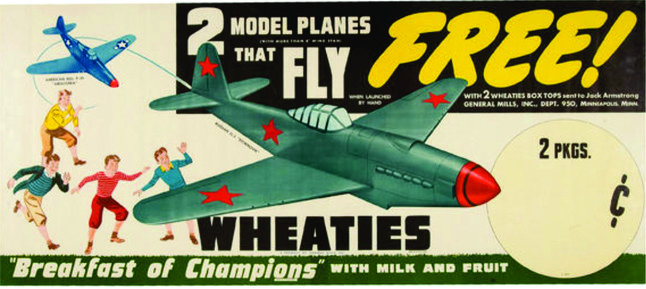
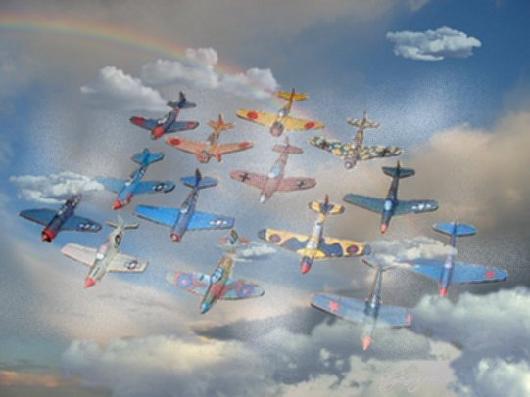
HISTORICAL NOTE: In 1944 during WWII The makers of Wheaties, General Mills Company, gave thousands of these models to our servicemen to build and fly while they recovered from their wartime injuries.
These WWII Wheaties model airplanes, the most popular fighters of the war, were also part of the Jack Armstrong Radio Show where the models were offered as Radio Premiums.
As these were constructed, the builder was required to put a penny in the nose for a nose weight. These models flew so well that National Championship Contests were organized. Awards were presented for best appearance, best maneuverability, and longest flight.
34. Tru-Flite Model Airplanes, (1943), Wheaties
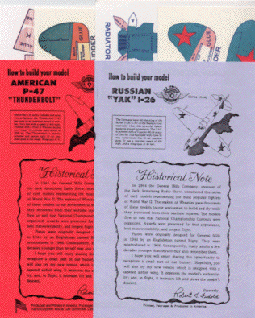 |
American and Russian |
35. Tru-Flite Model Airplanes, (1944), Wheaties
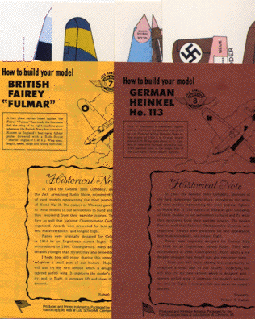 |
British and German |
36. Tru-Flite Model Airplanes, (1944), Wheaties
|
|
American and Russian |
37. Tru-Flite Model Airplanes, (1944), Wheaties
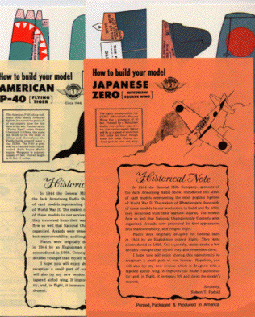 |
American and Japanese |
38. Tru-Flite Model Airplanes, (1944), Wheaties
|
|
American and Japanese |
39. Tru-Flite Model Airplanes, (1944), Wheaties
|
|
British and German |
40. Tru-Flite Set, (1944), Wheaties
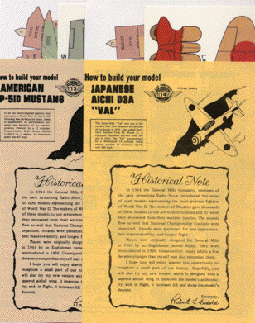 |
American and Japanese |
| Return to Beginning |
41. Tru-Flite Newspaper: Vol. 1-No. 1, (1944), Wheaties and
42. Tru-Flite Newspaper: Vol.1-No. 2, (1944), Wheaties
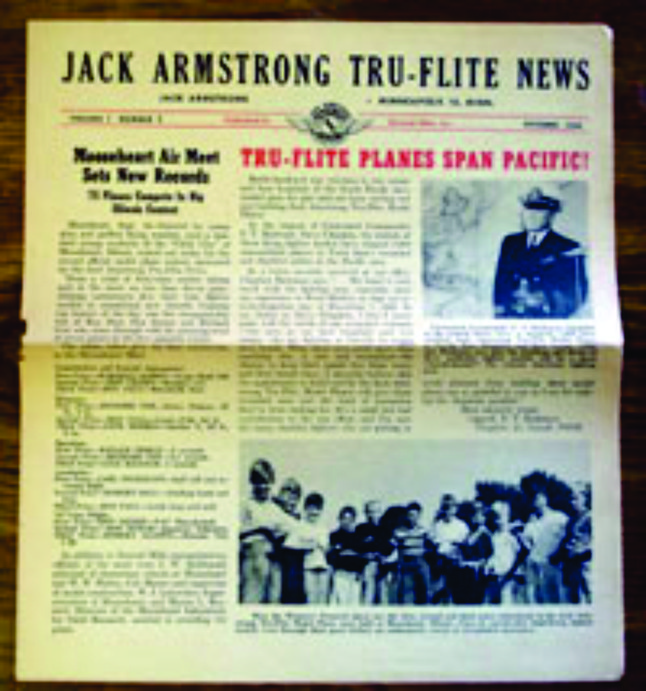 |
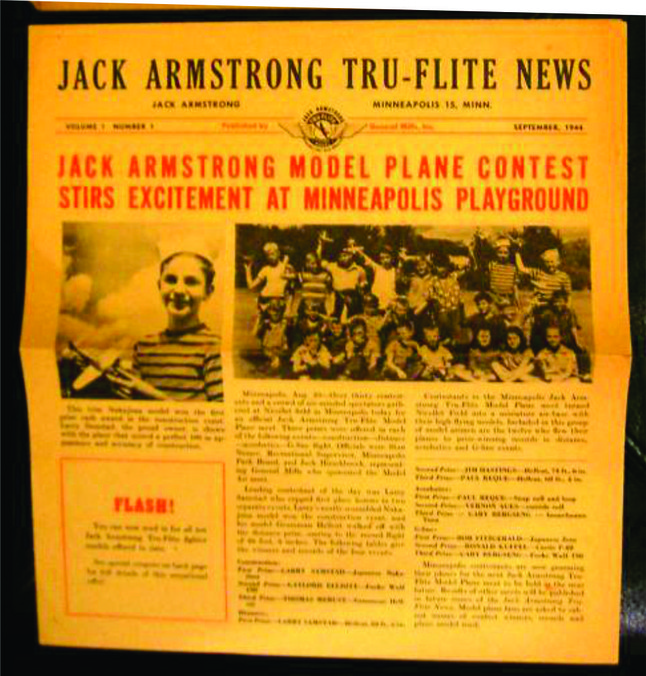 |
| Vol.1-1 | Vol.1-2 |
43. Japanese Zero, Paper Airplane, (1944), Wheaties
44. Cub Pilot Corp’s Training Kit, (1945), Wheaties
One of the final premiums offered by Jack Armstrong and Wheaties was the Cub Pilot Trainer, an ingenious cardboard-constructed console simulated the flying controls of a plane. The console contained a small Piper cub plane that responded to control-stick movements. A “How To Fly Manual” and a Cub Pilot Corps Newspaper were included. The manual, endorsed by the Piper Aircraft Corp., depicted photos of real Piper planes and also encouraged a trip to the local airport for a flying lesson.
45. Airplanes Of WWII, (1945-46), Wheaties
These were a set of 10 airplanes made from light pasteboard. Each had to be assembled.
46. Cub Pilot Corps Newspaper: Vol. 1-No. 1, (1945-46), Wheaties
47. Cub Pilot Corps, Transfer Ensemble, (1945-46), Wheaties
48. GI Identification Tag with Cub Pilot News, (1945-46), Wheaties
This 2 inch long thin-stamped metal plate in muted silver luster was first issued in 1934. Small text reads: "Official Member General Mills Cub Pilot Corps." In larger letters are the member's first and last name and their town and state.
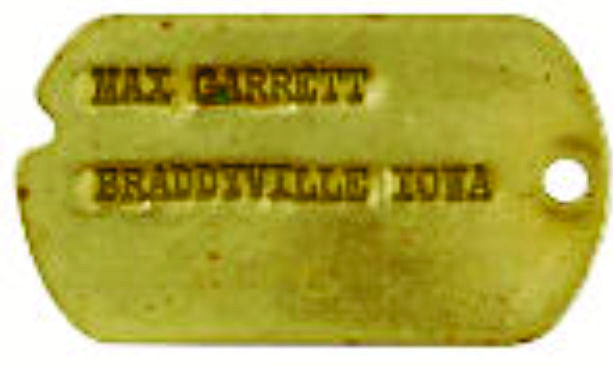
49. Preflight Trainer Model from Preflight Training Kit, (1945-46), Wheaties
50. Jack Armstrong "Name Your Bike" Contest, (1946), Wheaties
One thousand Columbia Streamliner bicycles were given away in the contest. All a listener had to do was submit a name for the bike he or she would like to win. The bikes were fully equipped with coaster brakes and balloon tires; and they came in red, for boys, and blue, for girls. A Wheaties box top was required for each name submitted.
51. Army Goggles, (1947), Wheaties
52. Golf Ball, Wheaties, (1947), Wheaties
53. Navy Signal Mirror, (1947), Wheaties
54. Parachute Ball, (1947), Wheaties
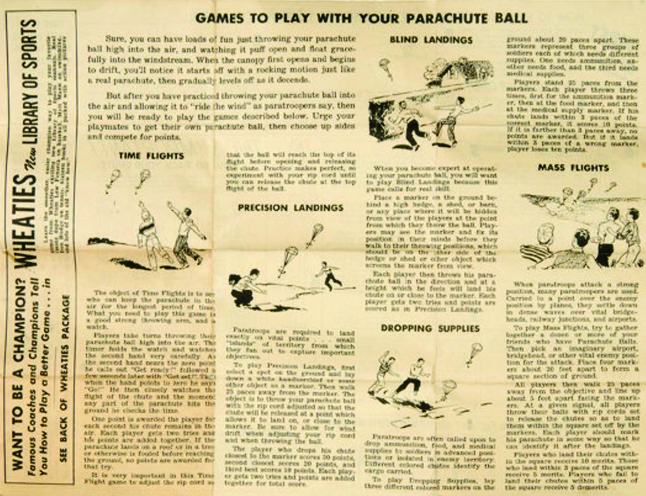 |
 |
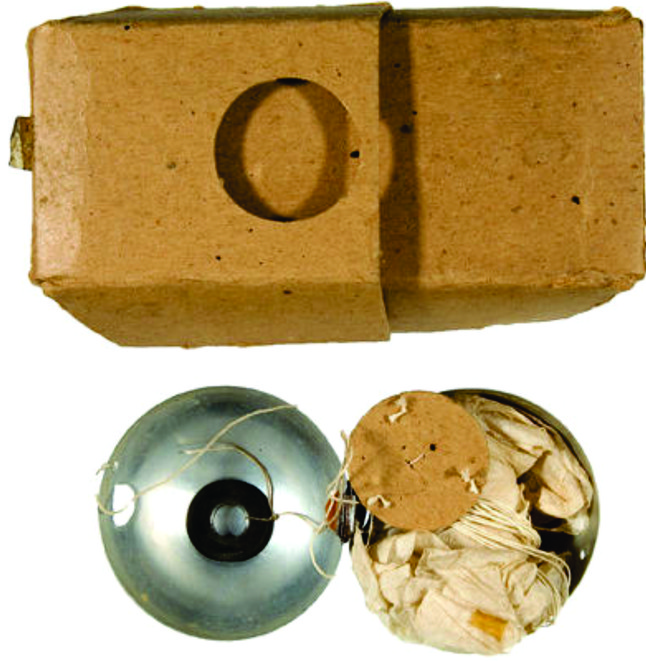 |
55. Sun Glasses, (1947), Wheaties
56. “Captain Marvel” Comic Book, (1948), Wheaties
57. “Funny Stuff’ Comic Book, (1948), Wheaties
This was a National Periodical Publication and came taped to the inside of the Wheaties box.
58. Frank Buck Explorer Sun Watch, (1948), Wheaties
This Jack Armstrong premium has a glow-in-the-dark face, with Frank Buck's signature on some models. It is a sundial and a compass in a brass base.
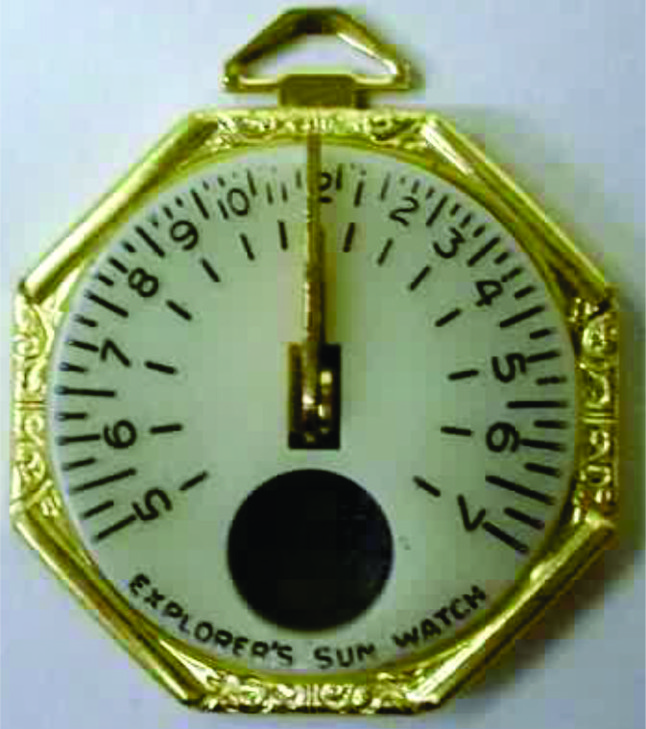
59. Postage Stamps, (1948), Wheaties
| Return to Beginning |
